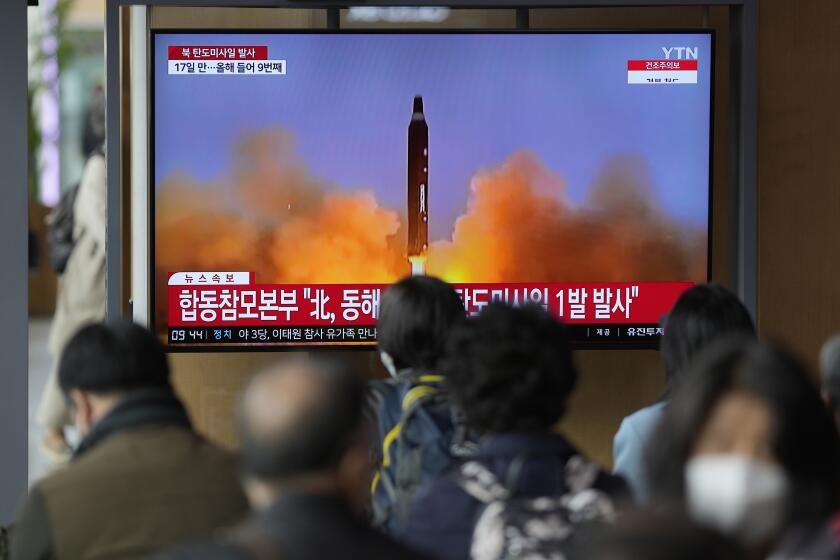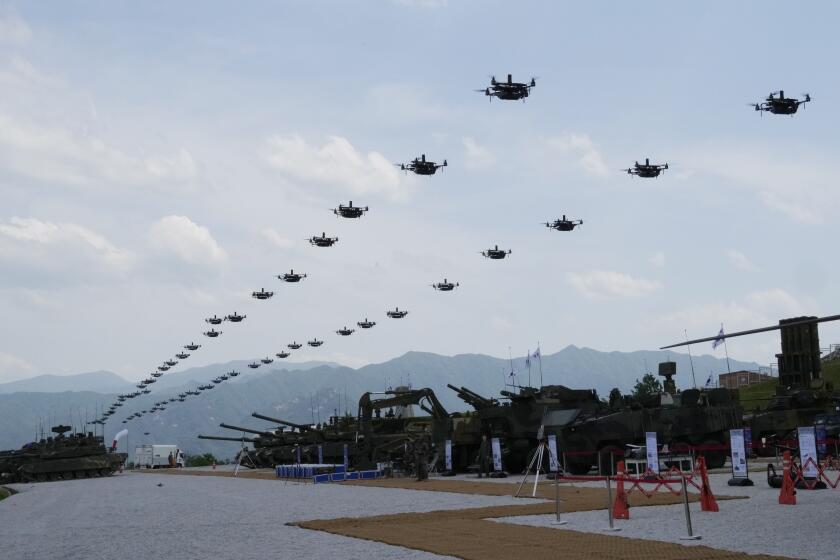North Korea says it will launch its first military spy satellite in June

- Share via
SEOUL, South Korea — North Korea said Tuesday it would launch its first military spy satellite in June and described space-based reconnaissance as crucial for monitoring the United States’ “reckless” military exercises with rival South Korea.
The statement came a day after North Korea notified Japan’s coast guard that it plans to launch a satellite sometime between May 31 and June 11 and that the event may have an affect in the Yellow Sea, East China Sea and areas east of the Philippines’ Luzon Island.
Japanese Defense Minister Yasukazu Hamada said he ordered the country’s Self-Defense Forces to shoot down the satellite or debris if they enter Japanese territory.
In comments published on state media, senior North Korean military official Ri Pyong Chol decried the combined U.S.-South Korean military exercises, which Pyongyang has long described as invasion rehearsals. He said North Korea considers space-based reconnaissance to be “indispensable” for monitoring the “dangerous military acts of the U.S. and its vassal forces,” which are “openly revealing their reckless ambition for aggression.”
North Korea since early 2022 has test-fired about 100 missiles, including intercontinental ballistic missiles designed to reach the U.S. mainland and launches it described as simulated nuclear attacks on targets in South Korea. North Korea has said its intensified testing activity is meant to counter its rivals’ joint military exercises as it continues to use the drills as a pretext to advance its arsenal of nuclear-capable weapons.
Its neighbors say North Korea has conducted a long-range missile launch as it extends a provocative run of weapons tests.
Last week, the South Korean and U.S. militaries conducted large-scale live-fire drills near the border with North Korea as the first of five rounds of exercises marking 70 years since the establishment of their alliance.
Ri said the expanding U.S.-South Korean military exercises — combined with stated U.S. plans to send nuclear-capable submarines to dock in South Korea and the increased activities of U.S. reconnaissance aircraft in the region — underscore a “sinister intention” to prepare for preemptive military action against the North. Washington and Seoul describe their regular military exercises as defensive; they have expanded the training since 2022 to cope with the North’s evolving threats.
The South Korean and U.S. militaries have conducted live-fire drills near the border with North Korea, despite warnings from Pyongyang.
“The concerning security environment prevailing in the region owing to the dangerous military acts by the U.S. and its vassal forces requires us to secure as the most pressing task a reliable reconnaissance and information means capable of gathering information about the military acts of the enemy in real time,” Ri said.
North Korea’s satellite launch would use long-range missile technology banned by past U.N. Security Council resolutions.
Spy satellites are among an array of high-tech weapons systems North Korean leader Kim Jong Un has publicly vowed to develop. Other systems on his wish list include solid-propellant ICBMs, nuclear-powered submarines, hypersonic missiles and multi-warhead missiles.
North Korea placed observation satellites in orbit in 2012 and 2016. While North Korea does not notify neighboring countries of its missile firings in advance, it has issued notices ahead of satellite launches.
Although North Korea has demonstrated an ability to deliver a satellite to space, there are questions about the capabilities of its technology. Foreign experts say the earlier satellites never transmitted imagery back to North Korea, and analysts say the new device, displayed in state media in recent weeks, appear too small and crudely designed to process and transfer high-resolution imagery.
South Korea warned Monday that North Korea will face consequences if it goes ahead with its launch plan in violation of the U.N. Security Council resolutions that ban the North from conducting any launch using ballistic technology.
More to Read
Sign up for Essential California
The most important California stories and recommendations in your inbox every morning.
You may occasionally receive promotional content from the Los Angeles Times.












